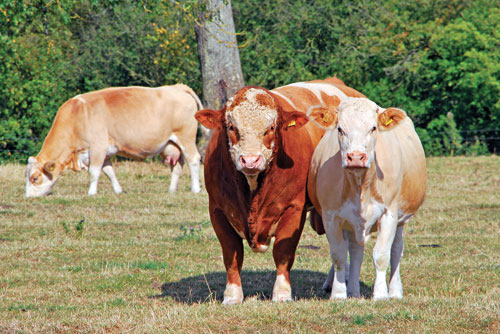Knowing normal vital signs in young animals can alert producers to health issues
When working with livestock, especially young ones, it’s important to catch health issues quickly so they can be treated swiftly and effectively. Knowing the vital sign for young animals and how to check for them can save a life.
Calves
A calf’s temperature should be between 100 and 102.5 degrees. Taking a calf’s temperature should be done rectally, and with a digital thermometer. Respiration rate for a calf is 36 to 60 breaths per minute. To check this, producers can watch the rise and fall of the calf’s body cavity while using a stopwatch; most smartphones have this feature. A stethoscope can also be utilized to detect any fluid or other issues within the lungs. The heart rate or pulse of a calf is between 100 to 140 beats per minute. This is typically twice as fast as the heart rate of an adult cow. The heart rate can be detected by placing two fingers over an artery – some of the most accessible arteries are under the jaw and the base of the tail.
Goat Kids
For goat kids, their temperature should be between 101.5 to 104 degrees, and should be taken rectally. A bit of lubricant can make this task easier. The respiration rate for a kid is between 20 to 40 breaths per minute. Observation or a stethoscope can be used. The pulse should be 70 to 80 beats per minute. The artery below the jaw works well, as does the artery on the inside of the thigh. Count the number of beats in 15 seconds and multiply by four.
Lambs
The normal temperature range for a lamb will be between 100.9 and 103.8 degrees. A lamb’s temperature is also taken rectally. The respiratory rate of a lamb should be between 12 to 20 breaths per minute, and their pulse is between 70 to 80 beats per minute.
Foals
A foal’s temperature should fall in between 100 and 102 degrees. The normal respiration rate is 15 to 20 breaths per minute, and the pulse rate is 70 to 90 beats per minute. Professors at the University of Arkansas Extension say the majority of a foal’s vital signs will be higher than those of mature horses, even under the same conditions.
If producers notice signs of potential health issues, such as tense or excitable behavior, runny nose, shivering, scours, not eating or drinking, or a decline in weight, they should be prepared to take vital signs, according to Andy McCorkill, livestock field specialist with the University of Missouri Extension. They should also contact their vetrinrian if they note vital signs that are not consistant.
Having a kit handy that contains a thermometer, lubricant, stethoscope and perhaps a small notebook can help speed up the process of taking a young animal’s vital signs.






